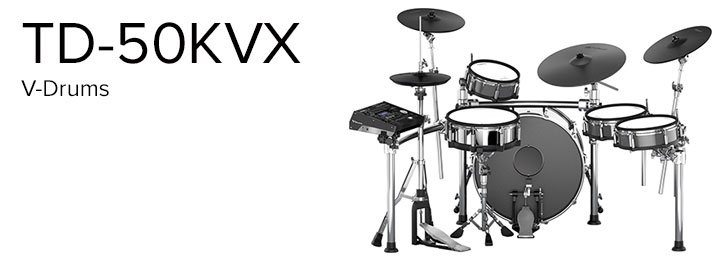If you’ve been wondering how to use WAV files with the TD-50, read this drummer’s guide all about triggering samples from V-Drums.
The sample load capability and myriad of editing possibilities in the Roland TD-50 allows you to freely combine sounds of your choice. As a result, you can create any drum sound you can dream up.
For instance, any of the 400+ internal sounds can be combined with your own WAV samples to create truly unique and world class sounding drum kits.
Importing sounds into V-Drums for live performance triggering is easy.
With basic sound preparation and a few button presses, it’s easy to load any WAV sound imaginable into the TD-50.
(Follow this link to learn how to prepare samples for V-Drums.)
For maximum musicality, WAV samples can be freely assign it to any pad surface to trigger sounds.
As far as sounds go, these can be acoustic drums, electronic sounds, loops and sound effects for example.
Tip: Once you have created your custom kit with any combination of factory sounds and user samples, you can save this new TD-50 kit patch along with its samples to an SD card as one simple file to share or add to your kit library.
Contributed by Simon Ayton for Roland Corporation Australia
1. Importing and working with WAV samples
In addition to the 400+ factory sounds, the TD-50 supports 500 additional 44.1 kHz 16 or 24bit resolution WAV audio files. As a result, world class custom drum sounds can be used.
For easy location, copy WAV files into named folders on an SD card or put them directly onto the uppermost root of the card.
Import USER SAMPLES directly into the internal memory and assign them to pads to play musically, for example.
Rather than needing to import backing tracks, the TD-50’s song player section can be used to play audio of any length directly from the SD card saving time.
WAV samples can be previewed before importing, meaning huge time savings.
For accurate sample editing of the start and end times of the imported user samples, use the built-in waveform editor.
As a result, streamlined samples trigger more accurately.
(Follow this link to learn how to prepare samples for V-Drums.)
TIP: Change the Play Type of the WAV sample from mono to poly for sounds that need to naturally overlap, such as cymbals and snare drums with reverb.
Hold [SHIFT] + [SETUP] (USER SAMPLE) | [F1] (IMPORT)
Hold [SHIFT] + [SETUP] (USER SAMPLE) | [F2] (SAMPLE LIST) | [F4] (PREVIEW)
2. How to Assign User Samples to Triggers
When using WAV Samples with the Roland TD-50, remember both factory and user samples can be freely assigned to triggers.
For instance, when creatively layering sounds, both the main instrument and its SUB layer can have WAV samples assigned, for blending and combining sounds however you like.
User samples can be single shot percussion sounds that play once through to the end, or phrases and loops can be set to ALT loop. As a result, these will start and stop with alternate hits.
Accessing Main Instrument
[INSTRUMENT] | [F1] (INST) | [ENTER] (INST LIST) | [F2] (GROUP) |
+- or data wheel to choose sound.
Accessing the SUB Layer
[INSTRUMENT] | [PAGE DOWN x4] | [F1] (INST) | [ENTER] (INST LIST) | [F2] (GROUP) |
+- or data wheel to choose sound.
Try:
IDEA #1: Jamming to Loops
Want to try some loops? Choose any preset kit and assign the factory user sample “U001 2Temp_BASS4” to the SUB layer on CRASH1 to jam along.
Tip: Unlink H&R [F5] to assign different sounds to the head and rim.
IDEA #2: Drum Plug-In Kit Sounds
Import and assign low and high velocity samples onto the Main or SUB instruments of any instrument.
Kick, snare and toms are natural first choices for example. Experiment with how they interact, using the various layer types.
For best playability and sound, use a similar factory sound for the main layer and a drum library sound for the SUB layer.
As a result, you will have nuance for rolls and positional awareness at low velocities.
IDEA #3: Wet Layering
For dramatic and interesting reverb effects, Import and assign dry samples to the main instrument and 100% wet reverb samples (no direct signal) to the SUB layer. Adjust the layering type and volume to determine how these wet and dry layers interact.
See the drummer’s guide to the TD-50 here
learn how to prepare samples for V-Drums.













